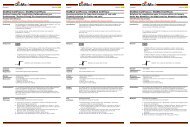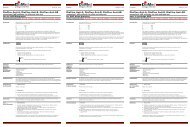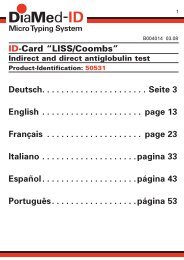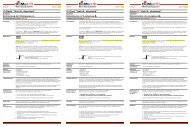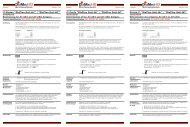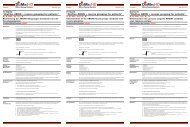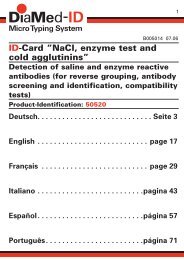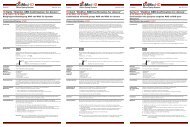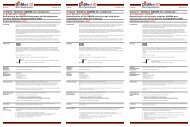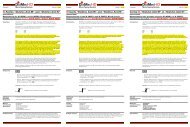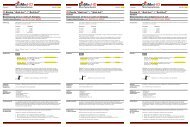“DiaCell I+II” and “DiaCell I+II+III”
“DiaCell I+II” and “DiaCell I+II+III”
“DiaCell I+II” and “DiaCell I+II+III”
- No tags were found...
Create successful ePaper yourself
Turn your PDF publications into a flip-book with our unique Google optimized e-Paper software.
Deutsch B109796 04.08 English B109796 04.08 Français B109796 04.08<strong>“DiaCell</strong> <strong>I+II”</strong> und <strong>“DiaCell</strong> <strong>I+II+III”</strong>Testerythrozyten für den Antikörper-Suchtest<strong>“DiaCell</strong> <strong>I+II”</strong> <strong>and</strong> <strong>“DiaCell</strong> <strong>I+II+III”</strong>Red cell reagents for antibody screening<strong>“DiaCell</strong> <strong>I+II”</strong> et <strong>“DiaCell</strong> <strong>I+II+III”</strong>Hématies-tests pour la recherche d’anticorpsEinleitungDie Zuverlässigkeit des Antikörpernachweises ist im wesentlichen von der Verfügbarkeit von Testerythrozyten mitgeeigneten Antigenen und der Empfindlichkeit der verwendeten Methode abhängig.IntroductionThe reliability of antibody detection is largely dependent on the availability of test cells with appropriate antigens<strong>and</strong> on the sensitivity of the test methods used.IntroductionLa fiabilité de la détection d’anticorps dépend largement de la disponibilité d’hématies-tests avec des antigènesappropriés et de la sensibilité des méthodes.Die Anforderungen an die Antigen-Konfiguration sind streng: sie muss die Feststellung der gewöhnlichauftretenden Antikörper mit potentieller klinischer Signifikanz ermöglichen. Da einige dieser Antikörper sichüber den Dosis Effekt manifestieren, ist es empfehlenswert, dass die Antigene des Rh-, Duffy-, Kidd und MNSBlutgruppensystem auf den Suchzellen in homozygoter Form vorliegen. Bestimmte Richtlinien verlangen, dasssowohl die Lewis-Antigene, als auch das seltene Kp(a) (KEL3) vorh<strong>and</strong>en sein müssen.The requirements for antigen configuration are stringent: it must allow the detection of commonly encounteredantibodies of potential clinical significance. Since some of these antibodies show a dosage effect, it is advisablethat screening cells possess antigens with presumed double dose expression within the Rh, Duffy, Kidd <strong>and</strong> MNSblood group systems. Certain guidelines require that the Lewis antigen be present, as should the rare antigenKp(a) (KEL3).Les exigences de la configuration antigénique sont rigoureuses: celles-ci doivent permettre la détection desanticorps cliniquement significatifs. Certains de ces anticorps présentent un effet de dose, il est donc souhaitableque les hématies-tests soient homozygotes dans les systèmes antigéniques concernés: Rhésus, Duffy, Kidd etsystème MNSs. Selon certaines directives, l’antigène Lewis, ainsi que l’antigène Kp(a) (KEL3) devraient êtreégalement inclus.Es wird allgemein als sicherer betrachtet zwei Testmethoden zu kombinieren, den indirekten Antiglobulintest (IAT)und die Enzymtechnik, die die Reaktionen bestimmter Antikörper erhöht, vor allem die vom Rh-, Kell- undKidd-System.In Anbetracht dieser Anforderung bietet DiaMed gebrauchsfertige Testerythrozyten für den IAT, die einstufigeEnzymtechnik oder für die Bestimmung von Kälteagglutininen mit der entsprechenden Methode an.It is generally considered most effective to combine two test methods, the indirect antiglobulin test (IAT) <strong>and</strong> anenzyme technique, which enhances the reactions of certain antibodies, notably in the Rh, Kell <strong>and</strong> Kidd Systems.Considering these requirements, DiaMed provides ready-to-use test cell reagents for the IAT, one-stage enzymetechnique or for the detection of cold agglutinins by the appropriate technique.Il est généralement admis comme plus sûr de combiner le test indirect à l’antiglobuline (TIA) et la techniqueenzymatique, qui augmente la réactivité de certains anticorps, notamment ceux des systèmes Rh, Kell et Kidd.En prenant en considération ces exigences, DiaMed fournit des hématies-tests prêtes à l’emploi pour le TIA, letest enzymatique à un temps ou la détection d’anticorps froids par la méthode appropriée.ReagenzienReagentsRéactifsTesterythrozyten der Blutgruppe O von Einzelspendern in einer Suspension von 3,0% ±1,0, in 10 mL Fläschchen.Konservierungsmittel: die Antibiotika Trimethoprim und Sulfamethoxazol.• <strong>“DiaCell</strong> <strong>I+II”</strong> (R 1 R 1 +R 2 R 2 ) oder (R 1wR 1 +R 2 R 2 )• <strong>“DiaCell</strong> <strong>I+II+III”</strong> (R 1wR 1 +R 2 R 2 +rr)Achtung: Die Ausgangsmaterialien, aus denen diese Produkte hergestellt wurden, haben sich bei der Prüfungmit zugelassenen Reagenzien als nicht reaktiv für HBsAg, HCV und HIV (1 und 2) erwiesen. Allerdings kannkein verfügbares Testverfahren das Nichtvorh<strong>and</strong>ensein infektiöser Substanzen garantieren. Aus Humanblutgewonnene Produkte sollten immer als potentiell infektiös angesehen werden.Group O red cells from single donors, in a suspension of 3,0% ±1,0, in 10 mL vials.Preservatives: the antibiotics trimethoprime <strong>and</strong> sulfamethoxazole.• <strong>“DiaCell</strong> <strong>I+II”</strong> (R 1 R 1 +R 2 R 2 ) or (R 1wR 1 +R 2 R 2 )• <strong>“DiaCell</strong> <strong>I+II+III”</strong> (R 1wR 1 +R 2 R 2 +rr)Caution: The source materials from which these products were manufactured, were found non-reactive forHBsAg, HCV <strong>and</strong> HIV (1+2) when tested with licensed reagents. However, no known test method can assure thatinfectious agents are absent. Products from human blood should be considered potentially infectious.Hématies-tests du groupe sanguin O provenant de donneurs individuels, en suspension à 3,0% ±1,0 en flacons de10 mL.Conservateurs: les antibiotiques triméthoprime et sulfaméthoxazole.• <strong>“DiaCell</strong> <strong>I+II”</strong> (R 1 R 1 +R 2 R 2 ) ou (R 1wR 1 +R 2 R 2 )• <strong>“DiaCell</strong> <strong>I+II+III”</strong> (R 1wR 1 +R 2 R 2 +rr)Attention: Les matières utilisées pour la fabrication de ces produits n’ont montré aucune réaction lors desdépistages de l’AgHBs, HIV1, HIV2 et HCV avec des réactifs licenciés. Cependant aucune des méthodes connuesne peut assurer l’absence d’agents infectieux. Les produits ayant pour origine du sang humain doivent êtreconsidérés comme des produits potentiellement infectieux.Stabilität: siehe Verfallsdatum auf dem Etikett.Stability: see expiry date on label.Stabilité: voir la date de péremption sur l’étiquette.ZusätzlichbenötigteReagenzien• 0,9%ige isotonische Kochsalzlösung• Verstärkermedien z.B. Rinderalbumin 30% (Id-n°: 11940)• DiaLISS (Id-n°: 12060)• Enzymreagenzien z.B “DiaBrom” für die Enzymtechnik (Id-n°: 12140)• Antihumanglobulinserum z.B. “DiaClon Coombs-serum” (Id-n°: 14060 oder 14070)• IgG-beladene Erythrozyten, z.B “Coombs-Control IgG” (Id-n°: 16070)Additionalreagentsrequired• 0,9% isotonic saline solution• Potentiating agents such as bovine albumin 30% (Id-n°: 11940)• DiaLISS (Id-n°: 12060)• Enzyme reagent such as “DiaBrom” to be used in enzyme techniques (Id-n°: 12140)• Anti-human globulin (AHG) serum such as “DiaClon Coombs-serum” (Id-n°: 14060 or 14070)• Cells coated with IgG such as “Coombs-Control IgG” (Id-n°: 16070)Réactifssupplémentairesnécessaires• Solution saline isotonique 0,9%• Agent de potentialisation tel que l’albumine bovine 30% (Id-n°: 11940)• DiaLISS (Id-n°: 12060)• Réactif enzymatique, tel que “DiaBrom”, à utiliser en techniques enzymatiques (Id-n°: 12140)• Réactif à l’antiglobuline humaine tel que le réactif DiaMed “DiaClon Coombs-serum” (Id-n°: 14060 ou 14070)• Hématies enrobées d’IgG telles que les hématies DiaMed “Coombs-Control IgG” (Id-n°: 16070)(siehe diesbezügliche Packungsbeilage)(see related package insert)(voir mode d’emploi correspondant)WeitereerforderlicheMaterialien• Suspensionsröhrchen• Röhrchenständer• Pipette• Immunhämatologische ZentrifugeFurthermaterialsrequired• Suspension tubes• Tube rack• Pipette• Immunohaematological centrifugeMatériauxsupplémentairesnécessaires• Tubes pour suspensions• Portoir de tubes• Pipette• Centrifugeuse immunohématologiqueProbenmaterialFür verlässliche Resultate sollte die Bestimmung mit frisch abgenommenen Proben durchgeführt werden oderin Übereinstimmung mit lokalen Laborvorschriften für die Akzeptanz von Probenmaterial erfolgen. Vorzugsweisesollte die Probengewinnung in den Antikoagulantien Citrat, EDTA oder CPD-A erfolgen. Native Proben (keinAntikoagulanz) können auch verwendet werden.SamplematerialFor optimal results, the determination should be performed using a freshly drawn sample, or in accordancewith local laboratory procedures for sample acceptance criteria. Preferably, blood samples should be drawn intocitrate, EDTA or CPD-A anticoagulant. Samples drawn into plain tubes (no anticoagulant) may also be used.EchantillonsAfin d’obtenir des résultats fiables, la détermination devrait se faire sur du matériel fraîchement prélevé ouconforme aux exigences du laboratoire auquel la dem<strong>and</strong>e d’analyses est adressée. L’échantillon devrait êtreprélevé de préférence sur anticoagulant citrate, EDTA ou CPD-A. Du sang prélevé sans anticoagulant (natif) peutégalement être utilisé.Wird Serum anstelle von Plasma verwendet, sollte dieses vor Testansatz 10 Minuten bei 1500 g zentrifugiertwerden, damit keine störenden Fibrinreste in dem Testansatz gelangen.When the use of serum instead of plasma is required, the serum must be well cleared, by centrifugation at 1500 gfor 10 minutes, before use avoid fibrin residues, which may interfere with the reaction pattern.Lorsque l’utilisation de sérum est préférable à celle de plasma, le sérum doit être obtenu par centrifugation à1500 g pendant 10 minutes pour éviter des résidus de fibrine qui pourraient interférer avec la réaction.Vorbereitungder Blutprobea) Erythrozytensuspension für die EigenkontrolleEine 3-5%ige Erythrozytensuspension in isotonischer Kochsalzlösung wie folgt zubereiten:1. 0,5 mL der isotonischen Kochsalzlösung in ein sauberes Glasröhrchen geben.2. 1 Tropfen (50 μL) Vollblut oder 25 μL Erythrozytenkonzentrat zugeben; leicht mischen.Preparationof blood samplea) Red cells suspension for autocontrolPrepare a 3-5% red cell suspension in isotonic saline solution as follows:1. Dispense 0,5 mL of isotonic saline solution into a clean tube.2. Add 1 drop (50 μL) of whole blood or 25 μL of packed cells; mix gently.Préparationde l‘échantillon desanga) Suspension d’hématies pour l’autocontrôlePréparer une suspension d’hématies à 3-5% en solution saline isotonique comme suit:1. Pipetter 0,5 mL de la solution saline isotonique dans un tube en verre propre.2. Ajouter 1 goutte (50 μL) de sang total ou 25 μL de culot d’hématies; mélanger doucement.b) Plasma oder Serumb) Plasma or serumb) Plasma ou sérumWird das Plasma oder Serum nicht unmittelbar nach dem Zentrifugieren verwendet, sollte es max. 48 Stunden bei2-8 °C, anschliessend bei -20 °C aufbewahrt werden.Samples that are not for immediate testing should be stored at 2-8 °C after separation for a maximum of48 hours, thereafter at -20 °C.Si les échantillons ne sont pas testés immédiatement, ils devront être conservés à 2-8 °C. Pour une conservationsupérieure à 48 heures, il est conseillé de les congeler à -20 °C.KontrollenBekannte Antigen-positive und -negative Erythrozyten sollten in Übereinstimmung mit den gültigen Richtlinienzur Qualitätssicherung mitgeführt werden.ControlsKnown positive <strong>and</strong> negative samples should be included in accordance with the relevant guidelines of qualityassurance.ContrôlesDes échantillons positifs et négatifs connus devront être inclus en concordance avec les régulations valables pourl’assurance de qualité.TestdurchführungenI. 3-Stufen Antihumanglobulintest mit Rinder-AlbuminTesterythrozyten vor Gebrauch auf Raumtemperatur bringen.Test proceduresI. 3-Step Anti-human globulin test with bovine albuminAllow test cell reagents to reach room temperature before use.MéthodesI. Test à l’antiglobuline humaine en milieu albumineux, en 3 phasesRamener les hématies-tests à température ambiante avant utilisation.1. Stufe (NaCl-Phase):1. Röhrchen mit den jeweiligen Zellen von <strong>“DiaCell</strong> <strong>I+II”</strong> oder <strong>“DiaCell</strong> <strong>I+II+III”</strong> und der Eigenkontrollebeschriften.2. In jedes Röhrchen je 1 Tropfen (50 μL) der entsprechenden Testerythrozyten und der Erythrozytensuspensiondes Patienten oder Spender für die Eigenkontrolle dazugeben.3. In jedes Röhrchen 2 Tropfen (100 μL) des zu untersuchenden Serums oder Plasmas dazugeben.4. Leicht mischen und während 5 Minuten bei Raumtemperatur (18-25 °C) inkubieren.5. 20 Sekunden bei 1000 g oder 1 Minute bei 125 g zentrifugieren.6. Erythrozyten vorsichtig resuspendieren und über einer indirekten Lichtquelle makroskopisch auf Agglutinationund/oder Hämolyse beobachten.1st step (NaCl-phase):1. Identify test tubes with the respective cells of <strong>“DiaCell</strong> <strong>I+II”</strong>or <strong>“DiaCell</strong> <strong>I+II+III”</strong> <strong>and</strong> the autocontrol.2. Add to each tube 1 drop (50 μL) of the corresponding test cells or the patient’s or donor’s red cell suspensionfor the autocontrol.3. Add to each tube 2 drops (100 μL) of the serum or plasma to be tested.4. Mix gently <strong>and</strong> incubate for 5 minutes at room temperature (18-25 °C).5. Centrifuge for 20 seconds at 1000 g or 1 minute at 125 g.6. Gently resuspend the cells <strong>and</strong>, over an indirect light source, observe macroscopically for agglutination <strong>and</strong>/orhaemolysis.1ère phase (phase NaCl):1. Identifier les tubes avec les hématies correspondantes de <strong>“DiaCell</strong> <strong>I+II”</strong> ou <strong>“DiaCell</strong> <strong>I+II+III”</strong> et l’autocontrôle.2. Distribuer dans chaque tube 1 goutte (50 μL) d’hématies-tests correspondantes et la suspension d’hématiesdu patient ou donneur pour l’autocontrôle.3. Ajouter dans chaque tube 2 gouttes (100 μL) du sérum ou plasma à examiner.4. Mélanger doucement et incuber pendant 5 minutes à température ambiante (18-25 °C).5. Centrifuger 20 secondes à 1000 g ou 1 minute à 125 g.6. Resuspendre doucement les hématies et, au-dessus d’un éclairage indirect, observer l’agglutinationmacroscopique ou une éventuelle hémolyse.2. Stufe (Albumin-Phase):7. In jedes Röhrchen 3 Tropfen (150 μL) Albumin 30% geben.8. Leicht mischen und 15-30 Minuten bei 37 °C inkubieren.9. 20 Sekunden bei 1000 g oder 1 Minute bei 125 g zentrifugieren.10. Erythrozyten vorsichtig resuspendieren und über einer indirekten Lichtquelle makroskopisch auf Agglutinationbeobachten.2nd step (Albumin-phase):7. Add to each tube 3 drops (150 μL) of bovine albumin 30%.8. Mix gently <strong>and</strong> incubate for 15-30 minutes at 37 °C.9. Centrifuge for 20 seconds at 1000 g or 1 minute at 125 g.10. Gently resuspend the cells <strong>and</strong>, over an indirect light source, observe macroscopically for agglutination.2ème phase (phase albumine):7. Ajouter dans chaque tube 3 gouttes (150 μL) d’albumine bovine 30%.8. Mélanger doucement et incuber pendant 15 à 30 minutes à 37 °C.9. Centrifuger 20 secondes à 1000 g ou 1 minute à 125 g.10. Resuspendre doucement les hématies et, au-dessus d’un éclairage indirect, observer l’agglutinationmacroscopique.3. Stufe (Antihumanglobulin-Phase):11. Inhalt der Röhrchen 3 x mit isotonischer Kochsalzlösung waschen. Überst<strong>and</strong> jeweils vollständig abgiessen.12. In jedes Röhrchen 2 Tropfen (100 μL) “DiaClon Coombs-serum” dazugeben.13. Leicht mischen und 20 Sekunden bei 1000 g oder 1 Minute bei 125 g zentrifugieren.14. Erythrozyten vorsichtig resuspendieren und über einer indirekten Lichtquelle makroskopisch auf Agglutinationbeobachten.15. Negative Reaktionen mit “DiaMed Coombs-Control IgG” bestätigen.3rd step (Anti-human globulin phase):11. Wash contents of tubes 3 times with isotonic saline solution <strong>and</strong> remove supernatant.12. Add to each tube 2 drops (100 μL) of “DiaClon Coombs-serum”.13. Mix gently <strong>and</strong> centrifuge for 20 seconds at 1000 g or 1 minute at 125 g.14. Gently resuspend the cells <strong>and</strong>, over an indirect light source, observe macroscopically for agglutination.15. Confirm negative results with “DiaMed Coombs-Control IgG”.3ème phase (phase à l’antiglobuline humaine):11. Laver 3 fois le contenu des tubes avec la solution saline isotonique et décanter le surnageant.12. Distribuer dans chaque tube 2 gouttes (100 μL) de réactif “DiaClon Coombs-serum”.13. Mélanger doucement et centrifuger 20 secondes à 1000 g ou 1 minute à 125 g.14. Resuspendre doucement les hématies et, au-dessus d’un éclairage indirect, observer l’agglutinationmacroscopique.15. Confirmer les réactions négatives avec les hématies “DiaMed Coombs-Control IgG”.
Français B109796 04.08 English B109796 04.08 Deutsch B109796 04.08II. Test enzymatique (avec “DiaBrom”)II. Enzyme test (with “DiaBrom”)II. Enzymtest (mit “DiaBrom”)1. Identifier les tubes avec les hématies correspondantes de <strong>“DiaCell</strong> <strong>I+II”</strong> ou <strong>“DiaCell</strong> <strong>I+II+III”</strong> et l’autocontrôle.2. Distribuer dans chaque tube 1 goutte (50 μL) d’hématies-tests correspondantes et la suspension d’hématiesdu patient ou du donneur pour l’autocontrôle.3. Ajouter dans chaque tube 1 goutte (50 μL) de “DiaBrom”.4. Mélanger doucement et laisser reposer pendant 1-2 minutes à température ambiante (18-25 °C).5. Ajouter dans chaque tube 2 gouttes (100 μL) du sérum ou plasma à examiner.6. Mélanger doucement et incuber pendant 15 minutes à 37 °C (ne pas dépasser les 15 minutes).7. Centrifuger 20 secondes à 1000 g ou 1 minute à 125 g.8. Resuspendre doucement les hématies et, au-dessus d’un éclairage indirect, observer l’agglutinationmacroscopique ou une éventuelle hémolyse.1. Identify test tubes with the respective cells of <strong>“DiaCell</strong> <strong>I+II”</strong>or <strong>“DiaCell</strong> <strong>I+II+III”</strong> <strong>and</strong> the autocontrol.2. Add to each tube 1 drop (50 μL) of the corresponding test cells <strong>and</strong> the patient’s or donor’s red cell suspensionfor the autocontrol.3. Add to each tube 1 drop (50 μL) of “DiaBrom”.4. Mix gently <strong>and</strong> incubate for 1-2 minutes at room temperature (18-25 °C).5. Add to each tube 2 drops (100 μL) of the serum or plasma to be tested.6. Mix gently <strong>and</strong> incubate for 15 minutes at 37 °C (do not exceed 15 minutes).7. Centrifuge for 20 seconds at 1000 g or 1 minute at 125 g.8. Gently resuspend the cells <strong>and</strong>, over an indirect light source, observe macroscopically for agglutination <strong>and</strong>/orhaemolysis.1. Röhrchen mit den jeweiligen Zellen von <strong>“DiaCell</strong> <strong>I+II”</strong> oder <strong>“DiaCell</strong> <strong>I+II+III”</strong> und der Eigenkontrollebeschriften.2. In jedes Röhrchen je 1 Tropfen (50 μL) der entsprechenden Testerythrozyten und der Erythrozytensuspensiondes Patienten oder Spender für die Eigenkontrolle dazugeben.3. In jedes Röhrchen 1 Tropfen (50 μL) “DiaBrom” dazugeben.4. Leicht mischen und 1-2 Minuten bei Raumtemperatur (18-25 °C) inkubieren.5. In jedes Röhrchen 2 Tropfen (100 μL) des zu untersuchenden Serums oder Plasmas dazugeben.6. Leicht mischen und 15 Minuten bei 37 °C inkubieren (15 Minuten nicht überschreiten).7. 20 Sekunden bei 1000 g oder 1 Minute bei 125 g zentrifugieren.8. Erythrozyten vorsichtig resuspendieren und über einer indirekten Lichtquelle makroskopisch auf Agglutinationund/oder Hämolyse beobachten.III. Technique de LISS (avec DiaLISS, réactif de LISS mod.)III. LISS technique with DiaLISS (mod. LISS reagent)III. LISS-Technik mit DiaLISS (mod. LISS-Reagenz)1ère phase (phase NaCl):1st step (NaCl-Phase):1. Stufe (NaCl-Phase):1. Identifier les tubes avec les hématies correspondantes de <strong>“DiaCell</strong> <strong>I+II”</strong> ou <strong>“DiaCell</strong> <strong>I+II+III”</strong> et l’autocontrôle.2. Distribuer dans chaque tube 1 goutte (50 μL) d’hématies-tests correspondantes et la suspension d’hématiesdu patient ou du donneur pour l’autocontrôle.3. Ajouter dans chaque tube 2 gouttes (100 μL) du sérum ou plasma à examiner.4. Mélanger doucement et incuber pendant 5 minutes à température ambiante (18-25 °C).5. Centrifuger 20 secondes à 1000 g ou 1 minute à 125 g.6. Resuspendre doucement les hématies et, au-dessus d’un éclairage indirect, observer l’agglutinationmacroscopique ou une éventuelle hémolyse.1. Identify test tubes with the respective cells of <strong>“DiaCell</strong> <strong>I+II”</strong>or <strong>“DiaCell</strong> <strong>I+II+III”</strong> <strong>and</strong> the autocontrol.2. Add to each tube 1 drop (50 μL) of the corresponding test cells <strong>and</strong> the patient’s or donor’s red cell suspensionfor the autocontrol.3. Add to each tube 2 drops (100 μL) of the serum or plasma to be tested.4. Mix gently <strong>and</strong> incubate for 5 minutes at room temperature (18-25 °C).5. Centrifuge for 20 seconds at 1000 g or 1 minute at 125 g.6. Gently resuspend the cells <strong>and</strong>, over an indirect light source, observe macroscopically for agglutination <strong>and</strong>/orhaemolysis.1. Röhrchen mit den jeweiligen Zellen von <strong>“DiaCell</strong> <strong>I+II”</strong> oder <strong>“DiaCell</strong> <strong>I+II+III”</strong> und der Eigenkontrollebeschriften.2. In jedes Röhrchen je 1 Tropfen (50 μL) der entsprechenden Testerythrozyten und der Erythrozytensuspensiondes Patienten oder Spender für die Eigenkontrolle dazugeben.3. In jedes Röhrchen 2 Tropfen (100 μL) des zu untersuchenden Serums oder Plasmas dazugeben.4. Leicht mischen und 5 Minuten bei Raumtemperatur (18-25 °C) inkubieren.5. 20 Sekunden bei 1000 g oder 1 Minute bei 125 g zentrifugieren.6. Erythrozyten vorsichtig resuspendieren und über einer indirekten Lichtquelle makroskopisch auf Agglutinationund/oder Hämolyse beobachten.2ème phase (phase LISS/antiglobuline humaine):2nd step (LISS-Anti-human globulin phase):2. Stufe (LISS-Antihumanglobulinphase):7. Ajouter dans chaque tube 4 gouttes (200 μL) de “DiaLISS”.8. Mélanger doucement et incuber pendant 5-10 minutes à 37 °C.9. Laver 3 fois le contenu des tubes avec la solution saline isotonique et décanter le surnageant.10. Distribuer dans chaque tube 2 gouttes (100 μL) de réactif “DiaClon Coombs-serum”.11. Mélanger doucement et centrifuger 20 secondes à 1000 g ou 1 minute à 125 g.12. Resuspendre doucement les hématies et, au-dessus d’un éclairage indirect, observer l’agglutinationmacroscopique.13. Confirmer les réactions négatives avec les hématies “DiaMed Coombs-Control IgG”.7. Add to each tube 4 drops (200 μL) of “DiaLISS”.8. Mix gently <strong>and</strong> incubate for 5-10 minutes at 37 °C.9. Wash contents of tubes 3 times with isotonic saline solution <strong>and</strong> remove supernatant.10. Add to each tube 2 drops (100 μL) of “DiaClon Coombs-serum”.11. Mix gently <strong>and</strong> centrifuge for 20 seconds at 1000 g or 1 minute at 125 g.12. Gently resuspend the cells <strong>and</strong>, over an indirect light source, observe macroscopically for agglutination.13. Confirm negative reactions with “DiaMed Coombs-Control IgG”.7. In jedes Röhrchen 4 Tropfen (200 μL) “DiaLISS” dazugeben.8. Leicht mischen und 5-10 Minuten bei 37 °C inkubieren.9. Inhalt der Röhrchen 3 x mit isotonischer Kochsalzlösung waschen. Ueberst<strong>and</strong> jeweils vollständig abgiessen.10. In jedes Röhrchen 2 Tropfen (100 μL) “DiaClon Coombs-serum” dazugeben.11. Leicht mischen und 20 Sekunden bei 1000 g oder 1 Minute bei 125 g zentrifugieren.12. Erythrozyten vorsichtig resuspendieren und über einer indirekten Lichtquelle makroskopisch auf Agglutinationbeobachten.13. Negative Reaktionen mit “DiaMed Coombs-Control IgG” bestätigen.IV. Test pour détection d’anticorps froidsIV. Test for the detection of cold agglutininsIV. Test für den Nachweis von Kälteagglutininen1. Identifier les tubes avec les hématies correspondantes de <strong>“DiaCell</strong> <strong>I+II”</strong> ou <strong>“DiaCell</strong> <strong>I+II+III”</strong> et l’autocontrôle.2. Distribuer dans chaque tube 1 goutte (50 μL) d’hématies-tests correspondantes et la suspension d’hématiesdu patient ou du donneur pour l’autocontrôle.3. Ajouter dans chaque tube 2 gouttes (100 μL) du sérum ou plasma à examiner.4. Mélanger doucement et incuber pendant 30 minutes à 4 °C.5. Centrifuger 20 secondes à 1000 g ou 1 minute à 125 g.6. Resuspendre doucement les hématies et, au-dessus d’un éclairage indirect, observer l’agglutinationmacroscopique ou une éventuelle hémolyse.1. Identify test tubes with the respective cells of <strong>“DiaCell</strong> <strong>I+II”</strong>or <strong>“DiaCell</strong> <strong>I+II+III”</strong> <strong>and</strong> the autocontrol.2. Add to each tube 1 drop (50 μL) of the corresponding test cells <strong>and</strong> the patient’s or donor’s red cell suspensionfor autocontrol.3. Add to each tube 2 drops (100 μL) of the serum or plasma to be tested.4. Mix gently <strong>and</strong> incubate for 30 minutes at 4 °C.5. Centrifuge for 20 seconds at 1000 g or 1 minute at 125 g.6. Gently resuspend the cells <strong>and</strong>, over an indirect light source, observe macroscopically for agglutination <strong>and</strong>/orhaemolysis.1. Röhrchen mit den jeweiligen Zellen von <strong>“DiaCell</strong> <strong>I+II”</strong> oder <strong>“DiaCell</strong> <strong>I+II+III”</strong> und der Eigenkontrollebeschriften.2. In jedes Röhrchen je 1 Tropfen (50 μL) der entsprechenden Testerythrozyten und der Erythrozytensuspensiondes Patienten oder Spender für die Eigenkontrolle dazugeben.3. In jedes Röhrchen 2 Tropfen (100 μL) des zu untersuchenden Serums oder Plasmas dazugeben.4. Leicht mischen und während 30 Minuten bei 4 °C inkubieren.5. 20 Sekunden bei 1000 g oder 1 Minute bei 125 g zentrifugieren.6. Erythrozyten vorsichtig resuspendieren und über einer indirekten Lichtquelle makroskopisch auf Agglutinationund/oder Hämolyse beobachten.Interprétationdes résultatsRéactions pour la recherche d’anticorps• Une réaction négative indique l’absence d’anticorps irrégulier détectable dans le sérum ou plasma du patient oudonneur.• Une réaction positive indique la présence d’anticorps irréguliers. Inscrire les résultats obtenus sur la tabled’antigènes jointe. Vérifier que le numéro de lot des hématies tests <strong>“DiaCell</strong> <strong>I+II”</strong> ou <strong>“DiaCell</strong> <strong>I+II+III”</strong>corresponde au numéro de lot indiqué sur la table d’antigènes. Selon le type de réaction et la configurationantigénique, la spécificité de l’anticorps présent peut, dans la plupart des cas, être suspecté. Procéder aux testscomplémentaires pour l’identification de l’anticorps.• Une réaction positive avec une ou plusieurs des hématies-tests et un autocontrôle négatif indiquent la présenced’anticorps spécifique (voir Remarques).• Une réaction positive avec toutes les hématies-tests et un autocontrôle positif est probablement due à unauto-anticorps.• Dans le cas d’une réaction positive avec toutes les hématies-tests et un autocontrôle positif, mais avec une ouplusieures hématies-tests montrant une réaction positive plus forte que l’autocontrôle, un anticorps spécifiquepeut être présent et l’échantillon du patient devra être soumis à d’autres tests, afin d’établir la spécificité del’anticorps.Interpretationof the resultsReactions for antibody screening• A negative reaction indicates the absence of detectable irregular antibodies in the patient’s or donor’s serum orplasma.• A positive reaction indicates the presence of irregular antibodies. Enter the reactions obtained on the antigentable. Verify that the lot number of the test cell reagents <strong>“DiaCell</strong> <strong>I+II”</strong> or <strong>“DiaCell</strong> <strong>I+II+III”</strong> corresponds to the lotnumber indicated on the antigen table. Following the reaction pattern <strong>and</strong> the antigen configuration, the type ofantibody present may be indicated. Perform the usual further tests to identify the antibody.• A positive reaction with one or more test cells <strong>and</strong> a negative autocontrol suggest the presence of a specificantibody (as described under Remarks).• A positive reaction with all test cells <strong>and</strong> a positive autocontrol may be due to an autoantibody.• Where there is a positive reaction with all test cells <strong>and</strong> a positive autocontrol but with one or more test cellsshowing a stronger positive reaction than the autocontrol, the patient sample should be submitted for furthertesting, to investigate the possibility of an underlying allo-antibody.Interpretation derErgebnisseReaktionen des Antikörper-Suchtests• Eine negative Reaktion deutet darauf hin, dass im Serum oder Plasma des Patienten oder Spender keinenachweisbaren irregulären Antikörper vorh<strong>and</strong>en sind.• Eine positive Reaktion weist auf irreguläre Antikörper hin. Die Reaktionen in die Antigentabelle eintragen.Überprüfen, ob die Chargennummer der Testerythrozyten <strong>“DiaCell</strong> <strong>I+II”</strong> oder <strong>“DiaCell</strong> <strong>I+II+III”</strong> der inder Antigentabelle angegebenen Chargennummer entspricht. Anh<strong>and</strong> des Reaktionsmusters und derAntigenkonfiguration kann auf den Typ des vorh<strong>and</strong>enen Antikörpers geschlossen werden. Die üblichenweiteren Tests zur Identifizierung des Antikörpers ausführen.• Eine positive Reaktion mit einer oder mehreren Testerythrozyten und eine negative Eigenkontrolle weisen aufeinen spezifischen Alloantikörper hin (siehe Anmerkungen).• Eine positive Reaktion mit allen Testerythrozyten und eine positive Eigenkontrolle sind wahrscheinlich aufAutoantikörper zurückzuführen.• Wenn bei allen Testerythrozyten und der Eigenkontrolle eine positive Reaktion auftritt, jedoch eine odermehrere Testerythrozyten eine stärker positive Reaktion zeigen als die Eigenkontrolle, so ist davon auszugehen,dass neben der nichtspezifischen Reaktion eventuell ein spezifischer Antikörper vorh<strong>and</strong>en ist. Die Probe desPatienten sollte weiteren Tests unterzogen werden.Remarques1. Il est recomm<strong>and</strong>é d’inclure le sérum de contrôle “DiaLISS” pour vérifier l’efficacité LISS/antiglobuline humaine(voir mode d’emploi “DiaLISS” et “DiaLISS control”).2. Dans chaque procédure, l’hémolyse des hématies-tests devrait être interprétée positive.3. Comme toutes les procédures suivant les règles des BPL, la sensibilité des techniques être validée parl’utilisation des anticorps avec concentration connue. Le réactif de référence DiaMed anti-D permet d’effectuerdes contrôles réguliers techniques de recherche d’anticorps (voir mode d’emploi correspondant).Remarks1. It is advisable to use “DiaLISS” control serum to monitor the LISS-anti-human globulin test (please consultpackage inserts “DiaLISS” <strong>and</strong> “DiaLISS control”).2. Haemolysis of the test cells in any procedure should be interpreted as a positive reaction.3. As for all procedures covered by GLP rules, the sensitivity of the above procedures should be validated usingantibodies of known potency. The DiaMed Anti-D reference reagent provides the means to regularly performcontrols for all antibody detection procedures (see related package insert).Anmerkungen1. Es wird empfohlen “DiaLISS”-Kontrollserum zu verwenden, um den LISS-Antihumanglobulintest zu bestätigen(siehe diesbezügliche Packungbeilage “Dia-LISS” und “DiaLISS control”).2. Eine Hämolyse der Testerythrozyten in jedem Verfahren sollte als positive Reaktion interpretiert werden.3. Wie bei allen Methoden, abgesichert durch GLP, sollte die Sensitivität der erwähnten Verfahren durchAntikörper mit bekannter Konzentration bestätigt werden. DiaMed Anti-D Referenz-Reagenz steht zurregelmässigen Kontrolle aller Antikörper Nachweisverfahren zur Verfügung (siehe diesbezüglichePackungsbeilage).Limitesa) Les méthodes enzymtatiques à un temps sont connues comme étant moins sensibles pour la détectiond’anticorps que la méthode à deux temps.b) Les conditions optimales de réaction peuvent varier considérablement d’un type d’anticorps à un autre. Enconséquence, toute procédure de test unique peut être insuffisante pour révéler tous les anticorps et desprocédures de tests combinés devront être appliquées.c) Certains médicaments sont connus pour entraîner des résultats positifs avec le test à l’antiglobuline humaine.d) Quelques états pathologiques ont été décrits lors de résultats positifs avec le test à l’antiglobuline humaine.e) Des contaminations, bactériennes ou autres, du matériel utilisé peuvent provoquer des résultats faussementpositifs ou faussement négatifs.f) L’observation stricte des méthodes et l’emploi de l’équipement recomm<strong>and</strong>é sont essentiels. L’équipementdoit être régulièrement contrôlé selon les procédures des BPL.g) Une phase de lavage incorrecte ou la présence de globulines humaines dans le tube peuvent neutraliser leréactif à l’antiglobuline humaine et être ainsi à l’origine de réactions faussement faibles voire faussementnégatives.h) Une agitation non appropriée en fin de procédure peut altérer le degré de positivité des réactions.Limitationsa) One-stage enzyme methods are known to be less sensitive for antibody detection than the two-stagetechnique.b) The optimal reaction conditions may vary considerably from one type of antibody to another. Consequently,one single test method may be insufficient to detect all antibodies <strong>and</strong> combined test procedures should beapplied.c) Certain drugs are known to cause positive reactions in anti-human globulin procedures.d) Some pathological conditions are also reported as causing positive reactions in anti-human globulinprocedures.e) Bacterial or other contamination of materials used can cause false positive or false negative results.f) Strict adherence to the procedures <strong>and</strong> recommended equipment is essential. The equipment should bechecked regularly according to GLP procedures.g) An inadequate wash phase or the presence of human globulins in the glassware may neutralise theanti-humanglobulin serum, resulting in a falsely weak or negative reaction.h) Inappropriate agitation of the completed test may downgrade positive reactions.Einschränkungena) Im Vergleich zur Zwei-Stufen Enzymtechnik sind Ein-Stufen Enzym-Methoden als weniger empfindlich für denAntikörpernachweis bekannt.b) Die optimalen Reaktionsbedingungen können erheblich von einem Antikörpertyp zum <strong>and</strong>eren schwanken.Folglich kann eine einzige Testmethode für den Nachweis aller Antikörper unzureichend sein, und es solltenunterschiedliche Verfahren mitein<strong>and</strong>er kombiniert werden.c) Es ist bekannt, dass bestimmte Medikamente positive Reaktionen im AHG-Test hervorrufen können.d) Einige Krankheitsbilder können positive AHG-Reaktionen hervorrufen.e) Bakterielle oder <strong>and</strong>ere Kontaminationen des verwendeten Materials können falsch positive oder falschnegative Ergebnisse verursachen.f) Striktes Befolgen der Anleitungen und Verwendung des erforderlichen Arbeitmaterials sind unerlässlich. DasArbeitsmaterial sollte regelmässig entsprechend der GLP - Richtlinien überprüft werden.g) Eine unzureichende Waschphase oder das Vorliegen humaner Globuline in den verwendeten Glasgeräten kanneine Neutralisation des Antihumanglobulinserums bewirken und folglich zu einer fälschlicherweise schwachenoder negativen Reaktion führen.h) Zu starkes Aufschütteln der Erythrozytensedimente kann eine Abschwächung der positiven Reaktionenbewirken.Bibliographie 1. Technical Manual: 13 th ed., 1999; American Association of Blood Banks. Bibliography 1. Technical Manual: 13 th ed., 1999; American Association of Blood Banks. Literatur 1. Technical Manual: 13 th ed., 1999; American Association of Blood Banks.Produits <strong>“DiaCell</strong> <strong>I+II”</strong> (Id-n°: 45220) 2 x 10 mL . . . . . . . . . . . . .REF 109792<strong>“DiaCell</strong> <strong>I+II+III”</strong> (Id-n°: 45230) 3 x 10 mL . . . . . . . . . . . . .REF 109793Products <strong>“DiaCell</strong> <strong>I+II”</strong> (Id-n°: 45220) 2 x 10 mL . . . . . . . . . . . . .REF 109792<strong>“DiaCell</strong> <strong>I+II+III”</strong> (Id-n°: 45230) 3 x 10 mL . . . . . . . . . . . . .REF 109793Produkte <strong>“DiaCell</strong> <strong>I+II”</strong> (Id-n°: 45220) 2 x 10 mL . . . . . . . . . . . . .REF 109792<strong>“DiaCell</strong> <strong>I+II+III”</strong> (Id-n°: 45230) 3 x 10 mL . . . . . . . . . . . . .REF 109793Ces produits sont garantis quant à leurs propriétés et qualités stipulées sur l’étiquette et dans le mode opératoire.Le fabricant décline toute responsabilité pour les cas où ces produits seraient employés ou vendus à d’autresusages.These products are guaranteed to perform as described on the label <strong>and</strong> in the instruction sheet. Themanufacturer declines all responsibility arising out of the use or sale of these products in any way or for anypurpose other than those described therein.Für diese Produkte wird nur Garantie übernommen, wenn sie gemäss den Angaben auf dem Etikett und derAnwendungsvorschrift verwendet werden. Jegliche Verantwortung wird ausdrücklich abgelehnt, wenn dasPräparat für <strong>and</strong>ere Zwecke gebraucht oder verkauft wird.0123DiaMed SA, 1785 Cressier s/Morat, Suisse DiaMed AG, 1785 Cressier s/Morat, Switzerl<strong>and</strong> DiaMed AG, 1785 Cressier s/Morat, Schweiz01230123
Italiano B109796 04.08 Español B109796 04.08 Português B109796 04.08<strong>“DiaCell</strong> <strong>I+II”</strong> e <strong>“DiaCell</strong> <strong>I+II+III”</strong>Reagenti eritrocitici per screening anticorporale<strong>“DiaCell</strong> <strong>I+II”</strong> y <strong>“DiaCell</strong> <strong>I+II+III”</strong>Hematíes reactivo para el escrutinio de anticuerpos irregulares<strong>“DiaCell</strong> <strong>I+II”</strong> e <strong>“DiaCell</strong> <strong>I+II+III”</strong>Eritrócitos-teste pesquisa de anticorposIntroduzioneL’attendibilità della rilevazione degli anticorpi dipende in larga misura da emazie testo con antigeni appropriati edalla sensibilità dei metodi d’analisi utilizzati.IntroducciónLa fiabilidad de los escrutinios de anticuerpos depende en gran medida de la disponibilidad de células reactivocon una dotación adecuada y de la sensibilidad de los métodos empleados.IntroduçãoA fiabilidade da detecção de anticorpos depende, em gr<strong>and</strong>e medida, da disponibilidade de eritrócitos teste comos antigénios apropriados, bem como da sensibilidade dos métodos de teste utilizados.Per l‘identificazione di anticorpi irregolari é necessario che le emazie che costituiscono il pannello sianopredisposte accuratamente dal punto di vista antigenico. E‘ anche opportuno, per prevenire l‘“effetto dose“ chegli antigeni appartenenti ai sistemi Rh, Duffy, Kidd e MNS siano presenti in forma omozigote. Alcune direttiverichiedono la presenza nel pannello degli antigeni appartenenti al sistema Lewis, e dell’antigene raro Kp(a) (KEL3).In linea generale si considera più efficace eseguire lo screening anticorpale sia con il test indiretto perl’antiglobulina (IAT) che con tecniche enzimatiche, poiché questa combinazione aumenta la reattività dideterminati anticorpi, in particolare quelli dei sistemi Rh, Kell e Kidd.In considerazioni di tali esigenze, DiaMed offre reagenti eritrocitici pronti all’uso per il test indiretto perl’antiglobulina (IAT) e èper la tecnica enzimatica monofase o il rilevamento di agglutinine fredde conprocedimento appropriato.Los criterios de selección o los requerimientos de configuración antigénica de las células son muy rigurosos,deben asegurar la detección de todos los anticuerpos irregulares clínicamente significativos. Como algunos deestos anticuerpos presentan un efecto de dosis, es recomendable que los hematíes reactivo posean antígenoscon una expresión homocigótica en los sistemas de grupo sanguíneo Rh, Duffy, Kidd y MNS. Algunas directricesexigen la presencia del antígeno Lewis, y también la del antígeno infrecuente Kp(a) (KEL3).Generalmente se considera que lo más eficaz es combinar dos procedimientos, la prueba de antiglobulinaindirecta (PAI) y una técnica enzimática, la cual intensifica la reactividad de determinados anticuerpos,especialmente los dirigidos contra antígenos de los sistemas Rh, Kell y Kidd.Teniendo en cuenta estos requisitos, DiaMed proporciona reactivos eritrocitarios para ser empleados en lapruebas de antiglobulina indirecta (PAI), para la técnica enzimática en una fase o para la detección de aglutininasfrías según el método correspondiente.Os requisitos para configuração de anticorpos são rigorosos: têm de permitir a detecção de anticorpos compotencial significado clínico. Dado que alguns anticorpos apresentam efeito de dosagem, os eritrócitos depesquisa deveriam possuir antigénios em forma supostamente dupla dentro dos grupos sanguíneos Rh, Duffy,Kidd e MNS. Certas directrizes exigem a presença do antígeno Lewis, bem como do antigénio raro Kp(a) (KEL3).De um modo geral é considerado mais eficaz combinar dois métodos de teste, o teste de antiglobulina indirecto(TAI) e uma técnica enzimática, a qual melhora a reactividade de certos anticorpos, nomeadamente nos sistemasRh, Kell e Kidd.Tendo em conta estas necessidades, a DiaMed fornece eritrócitos-teste para o TAI, uma técnica enzimática de umsó passo para detecção de aglutinininas frias pelo método adequado.ReagentiReactivosReagentesEritrociti del gruppo sanguigno O di singoli donatori, in una sospensione al 3,0% ±1,0, in flaconi da 10 mL.Eritrocitos del grupo O de donantes únicos, en una suspensión al 3,0% ±1,0, en frascos de 10 mL.Eritrócitos do grupo O de dadores únicos, em suspensão a 3,0% ±1,0, em frascos de 10 mL.Conservanti: trimetoprim e sulfametoxazolo.Conservantes: los antibióticos trimetoprim y sulfametoxazol.Conservantes: os antibióticos trimetoprim e sulfametoxazol.• <strong>“DiaCell</strong> <strong>I+II”</strong> (R 1 R 1 +R 2 R 2 ) o (R 1wR 1 +R 2 R 2 )• <strong>“DiaCell</strong> <strong>I+II”</strong> (R 1 R 1 +R 2 R 2 ) o (R 1wR 1 +R 2 R 2 )• <strong>“DiaCell</strong> <strong>I+II”</strong> (R 1 R 1 +R 2 R 2 ) ou (R 1wR 1 +R 2 R 2 )• <strong>“DiaCell</strong> <strong>I+II+III”</strong> (R 1wR 1 +R 2 R 2 +rr)• <strong>“DiaCell</strong> <strong>I+II+III”</strong> (R 1wR 1 +R 2 R 2 +rr)• <strong>“DiaCell</strong> <strong>I+II+III”</strong> (R 1wR 1 +R 2 R 2 +rr)Attenzione: i materiali originari da cui sono stati ottenuti questi prodotti sono risultati non reattivi a HBsAg,HCV e HIV (1+2) all‘analisi con reagenti autorizzati. Tuttavia non esiste alcun metodo di analisi noto che possagarantire l‘assenza di agenti infettivi. I prodotti derivati dal sangue umano devono essere sempre consideratipotenzialmente infettivi.Precaución: los materiales utilizados en la elaboración de estos productos resultaron ser no reactivos para HBsAg,VHC y VIH (1+2) en pruebas con reactivos autorizados. Sin embargo, no se conoce ningún método de prueba quepueda garantizar completamente la ausencia de agentes infecciosos. Los productos derivados de sangre humanadeben considerarse como potencialmente infecciosos.Atenção: As matérias-primas com que estes produtos foram produzidos não revelaram qualquer reacção aHBsAg, VHC e VIH (1+2) qu<strong>and</strong>o foram testadas com os reagentes aprovados. No entanto, nenhum método deteste conhecido pode garantir a ausência de agentes infecciosos. Os produtos originários de sangue humanodevem ser considerados potencialmente infecciosos.Stabilità: vedere la data di scadenza sull‘etichetta.Estabilidad: véase fecha de caducidad en la etiqueta.Estabilidade: ver prazo de validade no rótulo.Altrireagentioccorrenti• soluzione salina isotonica allo 0,9%• agenti di potenziamento come albumina bovina 30% (Id-n°: 11940)• DiaLISS (Id-n°: 12060)• reagente enzimatico come “DiaBrom” da utilizzarsi in tecniche enzimatiche (Id-n°: 12140)• siero all’antiglobulina umana come “DiaClon Coombs-serum”(Id-n°: 14060 o 14070)• DiaLISS (Id-n°: 16070)Reactivosadicionalesnecesarios• Solución salina isotónica al 0,9%• Agentes potenciadores, por ejemplo albúmina bovina al 30% (Id-n°: 11940)• DiaLISS (Id-n°: 12060)• Reactivos enzimáticos como “DiaBrom” para su uso en técnicas enzimáticas (Id-n°: 12140)• Suero antiglobulina humana (AHG), por ejemplo “DiaClon Coombs-serum” (Id-n°: 14060 o 14070)• Eritrocitos recubiertos con IgG, por ejemplo “Coombs-Control IgG” (Id-n°: 16070)Reagentesadicionaisnecessários• solução isotónica salina a 0,9%• Agentes potencializadores, como a albumina bovina 30% (Id-n°: 11940)• DiaLISS (Id-n°: 12060)• Reagentes enzimáticos tais como “DiaBrom” para utilização em técnicas enzimáticas (Id-n°: 12140)• Soro de antiglobulina humana (AGH), como “DiaClon Coombs-serum” (Id-n°: 14060 ou 14070)• Eritrócitos revestidos com IgG como no “Coombs-Control IgG” (Id-n°: 16070)(consultare la relativa scheda tecnica)(véase el prospecto correspondiente)(ver folheto informativo correspondente)Altrimaterialioccorrenti• Provette per sospensione• Rack per provette• Pipetta• Centrifuga per immunoematologiaOtrosmaterialesnecesarios• Tubos de suspensión• Gradilla para tubos• Pipeta• Centrífuga inmunohematológicaOutrosmateriaisnecessários• Tubos de Suspensão• Suporte para tubos• Pipeta• Centrífuga imuno-hematológicaCampioniPer ottenere risultati attendibili, si consiglia di eseguire la determinazione su un campione fresco o conformealle procedure del laboratorio per i criteri di accettazione dei campioni. I campioni devono essere prelevatipreferibilmente in citrato, EDTA o CPD-A. Si possono comunque usare anche campioni prelevati in provettenormali (senza anticoagulante).Se si richiede l‘uso di siero invece che di plasma, il siero deve essere ben chiarificato mediante centrifugazionea 1500 g per 10 minuti prima dell‘uso per evitare ogni residuo di fibrina che possa interferire con il pattern direazione.MuestrasPara un resultado óptimo, la determinación debe realizarse con una muestra recién extraída, o cumpliendola normativa local del laboratorio en cuanto a criterios de aceptabilidad de las muestras. Preferiblemente, lasmuestras de sangre deben recogerse utiliz<strong>and</strong>o citrato, EDTA o CPD-A como anticoagulante. También es posibleutilizar muestras recogidas en tubos sin anticoagulante.Cu<strong>and</strong>o sea necesario emplear suero en vez de plasma, el suero debe someterse a una centrifugación a 1500 gdurante 10 minutos antes de su uso, para evitar la presencia de residuos de fibrina que podrían interferir con elpatrón de reacción.AmostrasPara obtenção dos resultados ideais, a determinação deve ser realizada numa amostra recentemente colhida,ou em conformidade com os critérios de aceitação do procedimento laboratorial local. As amostras de sanguedevem, de preferência, ser colhidas em anticoagulante citrato, EDTA ou CPD-A. Também é possível utilizaramostras colhidas em tubos limpos (sem anticoagulante).Sempre que for preferível utilizar soro em vez de plasma, o soro deve ser bem limpo por centrifugação a1500 g durante 10 minutos antes de ser utilizado, a fim de evitar resíduos de fibrinas que poderiam interferir como padrão da reacção.Preparazionedel campionea) Sospensione di eritrociti per autocontrolloPreparare una sospensione di eritrociti al 3-5% in soluzione isotonica salina nel modo seguente:1. Pipettare 0,5 mL di soluzione salina isotonica in una provetta pulita.2. Aggiungere 1 goccia (50 μL) di sangue intero o 25 μL di emazie concentrate, mescolare delicatamente.Preparaciónde las muestras desangrea) Suspensión de eritrocitos para autocontrolPrepare una suspensión de eritrocitos al 3-5% en solución salina isotónica como sigue:1. Pipetee 0,5 mL de solución salina isotónica en un tubo limpio.2. Añada 1 gota (50 μL) de sangre completa o 25 μL de concentrado de eritrocitos y agite suavemente.Preparaçãoda amostra desanguea) Suspensão de eritrócitos para autocontroloPrepare uma suspensão de eritrócitos a 3-5% em solução isotónica salina do seguinte modo:1. Dispense 0,5 mL de solução isotónica salina num tubo de vidro limpo.2. Adicione 1 gota (50 μL) de sangue total ou 25 μL de concentrado de eritrócitos; misture suavemente.b) Plasma o sierob) Plasma o suerob) Plasma ou soroI campioni che non devono essere analizzati immediatamente vanno conservati a 2-8 °C dopo la separazione perun massimo di 48 ore, successivamente a -20 °C.Las muestras que no vayan a analizarse inmediatamente deben conservarse a 2 y 8 °C después de la separacióndurante un máximo de 48 horas, y posteriormente a -20 °C.No caso das amostras não serem testadas imediatamente, deverão ser conservadas a 2-8 °C após decantação nomáximo durante 48 horas, em seguida a -20 °C.ControlliSi consiglia di includere sempre controlli noti positivi e negativi in conformità alle direttive vigenti in materia digaranzia di qualità.ControlesDeben incluirse muestras positivas y negativas conocidas de acuerdo con las directrices de garantía de calidadaplicables.ControlosAmostras positivas e negativas conhecidas devem ser incluídas em conformidade com as directrizes relevantespara controlo da qualidade.Procedimentosto testeI. Test all’antiglobulina umana con albumina bovina in 3 fasiPrima dell‘uso portare i reagenti eritrocitici a temperatura ambiente.Procedimientosde las pruebasI. Prueba de la antiglobulina humanaen 3 pasos con albúmina bovinaDeje que los hematíes reactivos alcancen la temperatura ambiente antes de usarlos.Procedimentosdo testeI. Teste de antiglobulina humana com albumina bovina em 3 passosAntes de utilizar, deixe os eritrócitos-teste atingirem a temperatura ambiente.1. fase (fase NaCl):1. Identificare le provette di prova con le corrispondenti emazie testo <strong>“DiaCell</strong> <strong>I+II”</strong>o <strong>“DiaCell</strong> <strong>I+II+III”</strong> el’autocontrollo.2. Pipettare in ogni provetta 1 goccia (50 μL) delle corrispondenti emazie testo o della sospensione di eritrocitidel paziente o del donatore per l’autocontrollo.3. Aggiungere a ciascuna provetta 2 gocce (100 μL) del siero o del plasma da analizzare.4. Miscelare delicatamente e incubare per 5 minuti a temperatura ambiente (18-25 °C).5. Centrifugare per 20 secondi a 1000 g o per 1 minuto a 125 g.6. Risospendere delicatamente gli eritrociti e, su una sorgente luminosa indiretta, sottoporre a osservazionemacroscopica l’eventuale agglutinazione e/o emolisi.1er paso (fase NaCl):1. Identifique los tubos de ensayo correspondientes a los distintos hematíes reactivo de <strong>“DiaCell</strong> <strong>I+II”</strong>o <strong>“DiaCell</strong><strong>I+II+III”</strong> y del autocontrol.2. Añada a cada tubo 1 gota (50 μL) de los hematíes reactivo correspondientes, o de la suspensión de eritrocitosdel paciente o donante en el caso del autocontrol.3. Añada a cada tubo 2 gotas (100 μL) del suero o plasma que debe analizarse.4. Mezcle cuidadosamente e incube durante 5 minutos a temperatura ambiente (18-25 °C).5. Centrifugue 20 segundos a 1000 g ó 1 minuto a 125 g.6. Resuspenda cuidadosamente los eritrocitos y realice una observación macroscópica sobre una fuente de luzindirecta comprob<strong>and</strong>o si existe aglutinación o hemólisis.1° passo (fase NaCl):1. Identifique os tubos de teste com os eritrócitos correspondentes do <strong>“DiaCell</strong> <strong>I+II”</strong>ou do <strong>“DiaCell</strong> <strong>I+II+III”</strong> e doautocontrolo.2. A cada tubo adicione 1 gota (50 μL) dos eritrócitos-teste correspondentes e da suspensão eritrocitária dodoente ou do dador.3. Adicione a cada tubo 2 gotas (100 μL) do soro ou plasma a testar.4. Misture suavemente e incube durante 5 minutos à temperatura ambiente (18-25 °C).5. Centrifugue durante 20 segundos a 1000 g ou durante 1 minuto a 125 g.6. Volte a suspender suavemente os eritrócitos e verifique macroscopicamente sinais de aglutinação e/ou dehemólise sobre uma fonte de luz indirecta .2. fase (fase albumina):7. Pipettare in ogni provetta 3 gocce (150 μL) di albumina bovina al 30%.8. Miscelare delicatamente e incubare per 15-30 minuti a 37 °C.9. Centrifugare per 20 secondi a 1000 g o per 1 minuto a 125 g.10. Risospendere delicatamente gli eritrociti e, su una sorgente luminosa indiretta, sottoporre a osservazionemacroscopica l’eventuale agglutinazione.2er paso (fase de albúmina):7. Añada a cada tubo 3 gotas (150 μL) de albúmina bovina al 30%.8. Agite suavemente e incube durante 15-30 minutos a 37 °C.9. Centrifugue 20 segundos a 1000 g ó 1 minuto a 125 g.10. Resuspenda cuidadosamente los eritrocitos y realice una observación macroscópica sobre una fuente de luzindirecta comprob<strong>and</strong>o si existe aglutinación.2° passo (fase albumínica):7. Adicione a cada tubo 3 gotas (150 μL) de albumina bovina a 30%.8. Misture bem e incube durante 15-30 minutos a 37 °C.9. Centrifugue durante 20 segundos a 1000 g ou durante 1 minuto a 125 g.10. Volte a suspender suavemente os eritrócitos e verifique macroscopicamente sinais de aglutinação sobre umafonte de luz indirecta.3. fase (fase antiglobulina umana):11. Lavare il contenuto delle provette per 3 volte con soluzione salina isotonica, quindi rimuovere il surnatante.12. Aggiungere ad ogni provetta 1-2 gocce (100 μL) di “DiaClon Coombs-serum”.13. Miscelare leggermente e centrifugare per 20 secondi a 1000 g o per 1 minuto a 125 g.14. Risospendere delicatamente gli eritrociti e, su una sorgente luminosa indiretta, sottoporre a osservazionemacroscopica l’eventuale agglutinazione.15. Confermare le reazioni negative con “DiaMed Coombs-Control IgG”.3er paso (fase de antiglobulina humana):11. Lave 3 veces el contenido de los tubos con solución salina isotónica y elimine el sobrenadante.12. Añada a cada tubo 2 gotas (100 μL) de “DiaClon Coombs-serum”.13. Mezcle suavemente y centrifugue durante 20 segundos a 1000 g ó 1 minuto a 125 g.14. Resuspenda cuidadosamente los eritrocitos y realice una observación macroscópica sobre una fuente de luzindirecta comprob<strong>and</strong>o si existe aglutinación.15. Confirme los resultados negativos con “DiaMed Coombs-Control IgG”.3° passo (fase da antiglobulina humana):11. Lave o conteúdo dos tubos 3 vezes em solução isotónica salina e retire o sobrenadante.12. Adicione a cada tubo 2 gotas (100 μL) de “DiaClon Coombs-serum”.13. Misture suavemente e centrifugue durante 20 segundos a 1000 g ou durante 1 minuto a 125 g.14. Volte a suspender suavemente os eritrócitos e verifique macroscopicamente sinais de aglutinação sobre umafonte de luz indirecta.15. Confirme os resultados negativos com “DiaMed Coombs-Control IgG”.




